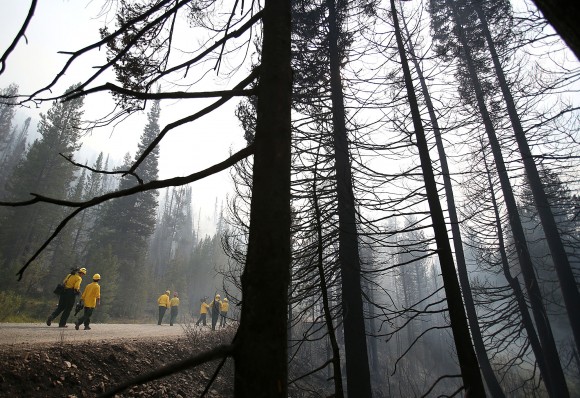Bill Potter wasn’t eager to abandon his high-end house last month during evacuations forced by a massive Idaho wildfire, but he felt reassured when his insurance company sent a team to protect his home near the world-class ski resort of Sun Valley.
“I was more than impressed,” he said of the water tanker truck and crew privately contracted by his insurer to patrol his road and keep watch over his family’s home, custom-crafted from parts of antique barns.
Potter is a member of the AIG Private Client Group, which is geared toward wealthy policyholders and offers a personal wildfire-protection program for customers in select areas in the western United States.
The program, still considered a novel service in a niche market, operates under the premise that it is cheaper to defend multimillion-dollar homes against fire than to replace them.
Companies such as AIG, Chubb and Fireman’s Fund are competing to offer extra layers of protection to “gold-plate” properties owned by the well-heeled, said Jim Whittle, assistant general counsel with the American Insurance Association.
Services range from clearing trees and brush from around a home before a fire can start to applying flame-retardant chemicals to the perimeter of a property in the midst of a blaze, according to industry literature.
Jack Dies, head of Sun Valley Insurance and an AIG broker, said premiums for such policies average up to $7,000 a year but those costs are dwarfed by the value of properties at stake.
Whittle could not quantify how widespread privately funded wildfire protection has become since first emerging less than a decade ago. But insurance plans offering such services have grown more popular as homes increasingly encroach on the “wildland-urban interface,” where the fringes of communities meet undeveloped, often rugged terrain.
Between 2000 and 2010, 10 million U.S. homes were built in or bordering fire-prone wild lands, representing two-thirds of all houses built during that period, according to research conducted by the U.S. Forest Service and others.
“It’s entirely likely it will be a continued pattern and approach,” Whittle said of private fire protection.
The presence of private firefighters gained greater attention this summer as dozens of large blazes raging across the drought-parched West strained traditional government firefighting resources at the local, state and federal levels.
Property losses are estimated to have run into the hundreds of millions of dollars.
AFFLUENT MOUNTAIN COMMUNITIES
Potter was one of thousands of residents forced in August to flee a wildfire in Idaho’s Sawtooth Mountains that threatened a scenic river valley whose homeowners included celebrities such as actor Tom Hanks. Land and properties in the area are collectively valued at up to $8 billion.
Hundreds of federal firefighters fought the blaze, battling flames door to door with support from water-dropping helicopters and airplane tankers. By the time it was over, the so-called Beaver Creek blaze had blackened 112,000 acres (45,300 hectares) of tinder-dry pine forests and sagebrush flats.
Just one home was lost in the blaze.
None of several insurers – including AIG – that underwrite multimillion-dollar homes in fire-prone regions agreed to interviews about wildfire protection services.
On its website, AIG Private Client Group pledges to use a proprietary wildfire mapping system to determine which of its insured homes are most vulnerable and to automatically send crews to take measures such as blanketing a house with fire-resistant foam. Homeowners are not required to alert the company or even be on the premises for the emergency fire protection clause to kick in.
Potter said he was unaware that his policy provided for such services until the AIG private fire crew arrived on his street.
“It must have been in the fine print of the contract. But I was duly impressed with their presence,” Potter said.
COSTLY POLICIES
Dies said crews hired by the company consist mostly of trained firemen with extensive fire-protection backgrounds.
“The theory is, if they can save one house, their bottom line is a whole lot better,” he said.
Firefighting experts still are evaluating how to best integrate insurance-hired resources.
Private crews out to protect specific individual properties in the midst of mass evacuations can pose a challenge to federal fire managers trying to marshal manpower and resources over a wide area, said Steve Gage, assistant operations director for fire and aviation management for the U.S. Forest Service.
He said the agency has sought to accommodate insurance company contract crews and engines in recognition of the valuable services they provide for certain homeowners. But tactics and objectives sometimes differ between traditional wildland firefighters and private asset-protection operations.
In some cases, the industry can end up competing with the government for a limited supply of contract fire engines and residents become concerned about what seems to be government crews working their neighbor’s home but not theirs, Gage said.
“The industry is about profit and loss and they’re in business to make money,” he said.
Topics USA Carriers Wildfire Homeowners AIG
Was this article valuable?
Here are more articles you may enjoy.



 SIAA Announces Strategic Partnership With Progressive
SIAA Announces Strategic Partnership With Progressive  Door of Swiss Bar Where 40 Died in Fire Was Locked, Says RTS
Door of Swiss Bar Where 40 Died in Fire Was Locked, Says RTS  Adjusters Launch ‘CarFax for Insurance Claims’ to Vet Carriers’ Damage Estimates
Adjusters Launch ‘CarFax for Insurance Claims’ to Vet Carriers’ Damage Estimates  10 Highest Class-Action Settlements in 2025 Eclipsed $70B Total: Duane Morris
10 Highest Class-Action Settlements in 2025 Eclipsed $70B Total: Duane Morris 

